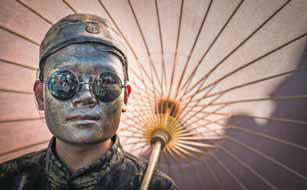Tianjin's rich cultural delights mix old and new
Updated: 2013-08-22 16:20
By Lance Crayon (China Daily)
|
||||||||
|
A folk artist performs as a "living statue" in Tianjin, where traditional cultural heritage is well preserved. Mitchell Masilun / for China Daily |
Despite having lived in Beijing for three years, I had never visited Tianjin.
I join the China Through the Eyes of Foreigners photography tour, and Tianjin is the third city stop on the two-week trek.
The first thing that surprises me about this city that is only a 30-minute train ride from the capital is the Western-style architecture of the buildings throughout Jiefangbei Road, the city's financial street.
The most striking building, for me anyway, is the Tianjin Custom Letter House.
Built in 1878, it officially became the Tianjin post office of the Qing Dynasty in 1897. It was at this post office that the first set of Chinese Dragon stamps were issued.
The reason there are so many examples of classical Western architecture is because Tianjin was one of the first Chinese cities to connect with the West as it was established as a treaty port in 1860.
Once the sun goes down, I take a short cruise along Haihe, the river that runs through the city.
At night, this stretch of water becomes the main attraction and gives visitors a glimpse of both modern and old Tianjin. New hotels are juxtaposed with buildings over 100 years old, and the view is spectacular.
The Tianjin Yangliuqing Fine Arts Press and the Clay Figurine Zhang craft shop are worth visiting as they prove that preserving China's folk art heritage and history is just as much a priority as developing a modern city.
Yangliuqing showcases ancient Chinese painting and writing. It's a living museum and has been a popular art form for more than 300 years. The press, which still produces traditional artwork, was listed as a part of the Chinese Intangible Cultural Heritage in 2006.
The Clay Figurine Zhang craft shop is a diamond in Tianjin. The historical clay figurines are made of ripe clay made from water and sand through a special weathering, filtrating and evaporation process, with the finishing touches applied to each figurine with a small cotton swab.
There are three small workshops where craftsmen create the Zhang figurines. Once completed, they are sold at the company's craft shop located on the second floor.
If you're searching for a unique gift, then this is the place to go. All works are original and created by hand on the spot.
In terms of cultural preservation, the city has not only set an example for other cities in China to follow, but for cities abroad to take notice in learning how to develop properly without sacrificing culture and heritage.
lance@chinadaily.com.cn
(China Daily USA 08/08/2013 page9)

 Manning gets 35 years in WikiLeaks trial
Manning gets 35 years in WikiLeaks trial
 At least 37 killed in Malaysian bus crash
At least 37 killed in Malaysian bus crash
 FM calls for closer Cambodia relations
FM calls for closer Cambodia relations Problems for rural kids in cities
Problems for rural kids in cities
 Search for escaped crocodiles continues
Search for escaped crocodiles continues
 Police break up baby trafficking ring
Police break up baby trafficking ring
 Jeremy Lin celebrates birthday in basketball clinic
Jeremy Lin celebrates birthday in basketball clinic
 Police identify suspect in US school shooting
Police identify suspect in US school shooting
Most Viewed
Editor's Picks

|

|

|

|

|

|
Today's Top News
Could Fed's QE-3 tapering come as soon as Sept?
Bo Xilai stands trial for bribery, embezzlement
Export rebound in US 'no big threat'
China will become No 1 oil importer
Affluent tourists 'go it alone'; seek culture, good food
Sales of iPad fall as Android-based devices gain
Manning gets 35 years in WikiLeaks trial
Illegal Chinese workers detained in Russia
US Weekly

|

|








